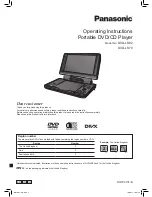
1-4
SERVICING PRECAUTIONS
CAUTION: Before servicing the DVD covered by this service
data and its supplements and addends, read and follow the
SAFETY PRECAUTIONS. NOTE: if unforeseen circumstances
create conflict between the following servicing precautions
and any of the safety precautions in this publication, always
follow the safety precautions.
Remember Safety First :
General Servicing Precautions
1. Always unplug the DVD AC power cord from the AC power
source before:
(1) Removing or reinstalling any component, circuit board,
module, or any other assembly.
(2) Disconnecting or reconnecting any internal electrical
plug or other electrical connection.
(3) Connecting a test substitute in parallel with an
electrolytic capacitor.
Caution
: A wrong part substitution or incorrect polarity
installation of electrolytic capacitors may result in an
explosion hazard.
2. Do not spray chemicals on or near this DVD or any of its
assemblies.
3. Unless specified otherwise in this service data, clean
electrical contacts by applying an appropriate contact
cleaning solution to the contacts with a pipe cleaner, cotton-
tipped swab, or comparable soft applicator.
Unless specified otherwise in this service data, lubrication of
contacts is not required.
4. Do not defeat any plug/socket B+ voltage interlocks with
which instruments covered by this service manual might be
equipped.
5. Do not apply AC power to this DVD and / or any of its
electrical assemblies unless all solid state device heat sinks
are correctly installed.
6. Always connect the test instrument ground lead to an
appropriate ground before connecting the test instrument
positive lead. Always remove the test instrument ground
lead last.
Insulation Checking Procedure
Disconnect the attachment plug from the AC outlet and turn
the power on. Connect an insulation resistance meter (500V)
to the blades of the attachment plug. The insulation resistance
between each blade of the attachment plug and accessible
conductive parts (Note 1) should be more than 1Mohm.
Note 1
: Accessible Conductive Parts include Metal panels,
Input terminals, Earphone jacks,etc.
Electrostatically Sensitive (ES) Devices
Some semiconductor (solid state) devices can be damaged
easily by static electricity. Such components commonly are
called Electrostatically Sensitive (ES) Devices. Examples of
typical ES devices are integrated circuits and some field effect
transistors and semiconductor chip components.
The following techniques should be used to help reduce the
incidence of component damage caused by static electricity.
1. Immediately before handling any semiconductor component
or semiconductor-equipped assembly, drain off any
electrostatic charge on your body by touching a known earth
ground. Alternatively, obtain and wear a commercially
available discharging wrist strap device, which should be
removed for potential shock reasons prior to applying power
to the unit under test.
2. After removing an electrical assembly equipped with ES
devices, place the assembly on a conductive surface such
as aluminum foil, to prevent electrostatic charge buildup or
exposure of the assembly.
3. Use only a grounded-tip soldering iron to solder or unsolder
ES devices.
4. Use only an anti-static solder removal device. Some solder
removal devices not classified as “anti-static” can generate
electrical charges sufficient to damage ES devices.
5. Do not use freon-propelled chemicals. These can generate
an electrical charge sufficient to damage ES devices.
6. Do not remove a replacement ES device from its protective
package until immediately before you are ready to install it.
(Most replacement ES devices are packaged with leads
electrically shorted together by conductive foam, aluminum
foil, or comparable conductive material).
7. Immediately before removing the protective material from
the leads of a replacement ES device, touch the protective
material to the chassis or circuit assembly into which the
device will be installed.
Caution: Be sure no power is applied to the chassis or
circuit, and observe all other safety precautions.
8. Minimize bodily motions when handling unpackaged
replacement ES devices. (Normally harmless motion such
as the brushing together of your clothes fabric or the lifting
of your foot from a carpeted floor can generate static
electricity sufficient to damage an ES device.)
Summary of Contents for T517AH
Page 9: ...1 8 MEMO ...
Page 30: ...3 17 FIG 7 2 DVD F FE RFL FIG 7 3 CD F FE RFL ...
Page 35: ...3 22 13 AUDIO OUTPUT FROM MT1389S FIG 13 1 ...
Page 36: ...3 23 CONNECTOR PICTURE 1 ALL CONNECTOR PICTURE ...
Page 37: ...3 24 2 MAIN BOARD CONNECTOR PICTURE ...
Page 38: ...3 25 CN201 MD 23PIN 3 CN201 CONNECTOR PICTURE CN202 MD 9PIN 4 CN202 CONNECTOR PICTURE ...
Page 39: ...3 26 CN602 POWER 10PIN 6 CN602 CONNECTOR PICTURE CN601 Front 12PIN 5 CN601 CONNECTOR PICTURE ...
Page 40: ...3 27 CN604 USB 4PIN 7 CN604 CONNECTOR PICTURE CN605 KARAOKE 4PIN 8 CN605 CONNECTOR PICTURE ...
Page 41: ...3 28 CN705 5 1ch 12PIN 9 CN705 CONNECTOR PICTURE ...
Page 49: ...3 37 3 38 2 MPEG CIRCUIT DIAGRAM ...
Page 50: ...3 39 3 40 3 SERVO CIRCUIT DIAGRAM ...
Page 51: ...3 41 3 42 4 JACK CIRCUIT DIAGRAM ...
Page 52: ...3 43 3 44 5 SCART CIRCUIT DIAGRAM OPTION ...
Page 53: ...3 45 3 46 6 USB CIRCUIT DIAGRAM 7 KEY CIRCUIT DIAGRAM ...
Page 54: ...3 47 3 48 8 TIMER CIRCUIT DIAGRAM ...
Page 57: ...3 53 3 54 PRINTED CIRCUIT BOARD DIAGRAMS 1 MAIN P C BOARD TOP VIEW BOTTOM VIEW ...
Page 59: ...3 57 3 58 5 SCART P C BOARD OPTION TOP VIEW BOTTOM VIEW 6 USB P C BOARD TOP VIEW BOTTOM VIEW ...
Page 65: ...4 6 MEMO ...
Page 67: ...4 9 4 10 MEMO MEMO ...






































